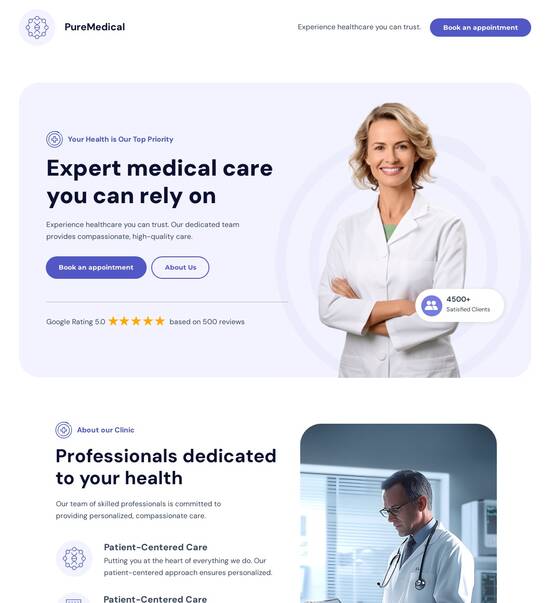
Glossary page template compatible with Squarespace
Explore Similar TemplatesAbout template
Build and integrate high-converting glossary page templates with Squarespace effortlessly!
Recommended templates

Easy to build without coding
With the intuitive drag-and-drop builder, anyone on your team can create high-converting pages without any knowledge of code or design. Make enhancements to your landing page with custom widgets using Javascript, HTML/CSS, or third-party scripts.

Multiple layouts for any industry and goal
Select from 500+ landing page layouts built to boost conversions across industry-specific scenarios. Customize them by adjusting fonts, adding images, and generating on-brand content with the AI assistant. Quickly scale with Instablocks® and Global Blocks that you can save, reuse, and update globally.

Loads fast and looks polished on any device
Every template is responsive, which means they present professionally on any device and load blazingly fast with our Thor Render Engine. You can also power them up with Google AMP technology to deliver an unparalleled mobile experience and drive higher conversions.

Robust analytics & experimentation
Get real-time updates and reporting across all your devices, showing the number of visitors, conversions, cost-per-visitor, and cost-per-lead. Launch AI-powered experiments, run A/B tests, and use heatmaps to analyze user behavior, then optimize your landing page to maximize conversions.







Easy to build without coding
With the intuitive drag-and-drop builder, anyone on your team can create high-converting pages without any knowledge of code or design. Make enhancements to your landing page with custom widgets using Javascript, HTML/CSS, or third-party scripts.
Multiple layouts for any industry and goal
Select from 500+ landing page layouts built to boost conversions across industry-specific scenarios. Customize them by adjusting fonts, adding images, and generating on-brand content with the AI assistant. Quickly scale with Instablocks® and Global Blocks that you can save, reuse, and update globally.
Loads fast and looks polished on any device
Every template is responsive, which means they present professionally on any device and load blazingly fast with our Thor Render Engine.
Robust analytics & experimentation
Get real-time updates and reporting across all your devices, showing the number of visitors, conversions, cost-per-visitor, and cost-per-lead. Launch AI-powered experiments, run A/B tests, and use heatmaps to analyze user behavior, then optimize your landing page to maximize conversions.
All the features you need to build lead-generating landing pages
Explore more featuresLearn how to build top-performing landing pages for any goal
FAQs
Leading the way in building high-performing landing pages





An all-in-one landing page platform for optimizing ROI
In the competitive landscape of digital marketing, leveraging the best tools is crucial for success. Instapage stands out as a powerful landing page and conversion rate optimization (CRO) platform, offering marketers essential features to maximize their campaigns' ROI effectively across diverse sectors such as education, financial services, and government.
Understanding the benefits of Instapage
Instapage is tailored to meet the needs of various industries, providing extensive resources to ensure optimized marketing efforts. With over 100 adaptable templates, marketers can initiate campaigns that capture leads efficiently without extensive design work. The platform's flexibility and user-friendliness allow users of every skill level to create high-converting pages quickly.
- Access to 100+ high-converting templates: These templates cater to different industries and can be customized without any coding.
- Built-in experimentation features: Optimize pages using A/B testing and heatmaps to analyze user interaction, leading to improved conversions.
- Personalized audience experiences: Utilize dynamic text replacement and audience tracking tools to deliver tailored content to different user groups.
Step 1: Create compelling landing pages
The first step in utilizing Instapage is to leverage its page builder for developing landing pages. Follow these guidelines:
- Choose a template that resonates with your campaign goals and aligns with your target audience's preferences.
- Customize your selected template by adding specific content, CTAs, and multimedia elements that reflect your brand.
- Utilize the intuitive builder to adjust layout settings, ensuring a seamless user experience across devices.
Step 2: Optimize for conversions
Next, focus on enhancing the effectiveness of your landing pages using the optimization tools provided.
- Conduct A/B tests: Test different headlines, layouts, or images to determine which variations drive better engagement.
- Implement heatmaps: Analyze where users click and scroll on your page to tweak layouts, enhancing user experience.
- Utilize analytics dashboard: Monitor performance metrics to ascertain which campaigns yield the highest ROI.
Step 3: Collaborate for success
Collaboration is key in marketing. Use Instapage's collaboration features to streamline the process.
- Share pages securely with team members and stakeholders for reviews.
- Provide instant feedback on designs or content adjustments to speed up the production cycle.
- Make real-time edits together, ensuring everyone involved has immediate access to the latest updates.
By adhering to these steps, marketers can harness Instapage's capabilities to create effective, high-converting landing pages tailored to their specific audience needs.
Start optimizing your digital marketing efforts today with Instapage and witness the transformation of your campaigns. Sign up now to explore a free trial!
People also ask about Glossary page template compatible with Squarespace
Creating a glossary page template compatible with Squarespace
Understanding the importance of a glossary page in modern websites
A glossary page serves as a vital resource for websites, especially those dealing with technical or specialized content. By defining complex terms, it aids visitors in navigating the website with ease. Essentially, a glossary not only clarifies jargon but also democratizes information, making it accessible to a broader audience. Moreover, it can significantly enhance user experience by providing visitors with a quick reference guide that allows them to understand content without external assistance.
The importance of a glossary also extends to site navigation. By incorporating an organized glossary, users can easily discover related content without needing to know the specific terms beforehand. This centralization of information means that visitors no longer have to sift through extensive content or search for definitions, making their journey through the website smoother and more intuitive.
Clarifying complex terminologies for diverse audiences.
Enhancing user experience through accessibility.
Improving content discoverability and navigation.
Providing a centralized resource for definitions.
Integrating a glossary page template with Squarespace
Squarespace stands out as a popular website builder renowned for its user-friendly design capabilities. It empowers users to create visually appealing sites with minimal effort. Squarespace offers various features, including customizable templates, which are ideal for building a glossary page. Whether you’re a small business or a large educational institution, Squarespace facilitates creating an elegant glossary that complements your overall site design.
Utilizing a glossary page template can streamline the process of adding defined terms. These templates are pre-designed to match Squarespace’s aesthetic while allowing customization to maintain brand identity. Marketers can save significant time and resources by selecting a ready-made template that works seamlessly with their existing site.
User-friendly design capabilities.
Available features for customization.
Streamlining the addition of defined terms.
Aligning with Squarespace’s design aesthetic.
Key features of a glossary page template for Squarespace
A polished glossary page template typically offers various layout options to ensure information is presented effectively. These layouts can either organize terms hierarchically or alphabetically, depending on user preference and content type. Customizable skins allow businesses to align the glossary's aesthetic with their branding, ensuring consistency across all web pages.
Furthermore, integration with widgets and plugins can significantly enhance a glossary's functionality and improve user engagement. Many third-party tools can aid in creating more interactive and comprehensive entries, making the glossary a lively part of the website. Lastly, it’s crucial to ensure that any glossary page way you create is responsive, providing an optimal browsing experience across all devices.
Hierarchical versus alphabetical organization of terms.
Customizable skins to match branding.
Enhancing functionality through third-party tools.
Ensuring mobile compatibility and adjusting layouts for different screen sizes.
Crafting effective content for your glossary
Creating a successful glossary page not only involves a functional layout but also compelling content. The first step to achieving relevance is identifying terms that resonate with your audience. This involves research into industry-specific terminology while also considering common queries that users might have. Understanding what your audience seeks will allow you to craft definitions that address their needs directly.
When writing definitions, clarity is paramount. Aim for simplicity and conciseness to ensure that terms are easily understandable. Strategies like using short sentences, active voice, and concrete examples can vastly improve comprehension. Additionally, consider incorporating multimedia elements such as images, videos, and hyperlinks to support text definitions. The inclusion of rich media not only makes definitions more engaging but can also help users retain information better.
Researching industry-specific terms.
Considering audience needs and common queries.
Strategies for readability and comprehension.
Incorporating images, videos, and links to support definitions.
Enhancing search engine optimization (SEO) with a glossary page
An effectively crafted glossary page also serves as an excellent tool for improving SEO. Conducting keyword research is essential in this process, as high-traffic keywords should be integrated into glossary entries. There are many tools available that can aid in identifying trending keywords, allowing marketers to smartly embed these terms within their content, increasing the likelihood of search visibility.
Proper structuring of your glossary content is equally crucial. Utilizing HTML tags effectively will help search engines categorize your terms appropriately. Furthermore, creating internal links between glossary terms and related site content will enhance user experience and facilitate better site navigation, essentially guiding visitors through their discovery journey. Monitoring performance through analytics can also provide insights into which glossary terms generate traffic and allow you to adapt content accordingly.
Tools to identify high-traffic keywords.
Implementing keywords within glossary content.
Utilizing proper HTML tags for terms.
Creating internal links to related content.
User experience and readability considerations
A well-structured glossary should prioritize user experience. Designing an intuitive navigation structure is the first step. Implementing filters and search bars can offer users quick access to specific terms, minimizing frustration. Furthermore, showcasing frequently referenced terms can make the search process much quicker, ensuring that users find what they need almost instantly.
Formatting plays a significant role in maintaining clarity in your glossary. Using bullet points or lists can break down complex definitions into easily digestible pieces of information. Balancing text density is key; avoid overwhelming users with walls of text. Furthermore, consider incorporating feedback mechanisms that allow visitors to contribute suggestions for terms or rate definitions, creating a sense of community around your glossary.
Implementing filters and search bars for quick access.
Highlighting frequently referenced terms.
Tips for using bullet points and lists for definitions.
Encouraging visitor contributions for term suggestions.
Resources and support for building a glossary page
Building a glossary page on Squarespace can be enhanced by utilizing available resources. Accessing Squarespace support and documentation can help you understand the best practices regarding templates and customization options specifically geared towards glossary pages. Engaging with the community via Squarespace forums can provide additional insights, allowing webmasters to learn from one another's experiences.
Moreover, seeking expert tips from industry professionals can be pivotal. The insights derived from experienced web designers who have implemented glossary pages can guide you in creating a practical and appealing glossary. Various tools are also available for efficient management of glossary content, enabling regular updates and improvements to ensure that your glossary remains relevant over time.
Understanding available templates and customization options.
Utilizing Squarespace forums for community assistance.
Interviews with web designers utilizing glossary pages.
Recommendations for ongoing content updates and improvements.
Case studies: successful glossary pages across industries
Examining successful glossary pages across various industries can provide valuable insights into best practices. In the e-commerce sector, glossary templates often include terminology that enhances product understanding, thereby facilitating a smoother shopping experience. For instance, a retail glossary that defines terms like 'SKU' or 'backorder' can significantly inform and guide customer decisions.
Educational websites, particularly universities, have also leveraged glossary pages effectively. These glossaries are structured to cater to student understanding, offering definitions for a wide breadth of academic terminology. A notable example is a university glossary that simplifies complex concepts in accessible language, further enhancing learning and comprehension for students.
Corporate websites frequently utilize glossaries to convey complex concepts in clear, business-friendly terms, especially within industries such as technology. For instance, a technology company’s glossary that clearly defines terms like 'cloud computing' or 'artificial intelligence' helps demystify these concepts for clients and stakeholders, ensuring that all parties are on the same page.
Examples of terminologies that enhance product understanding in e-commerce.
Structuring terms for student understanding in educational websites.
Conveying complex concepts in clear terms in corporate websites.
Ready to skyrocket conversions?
Supercharge your ad campaigns with high-performing landing pages
Get started














